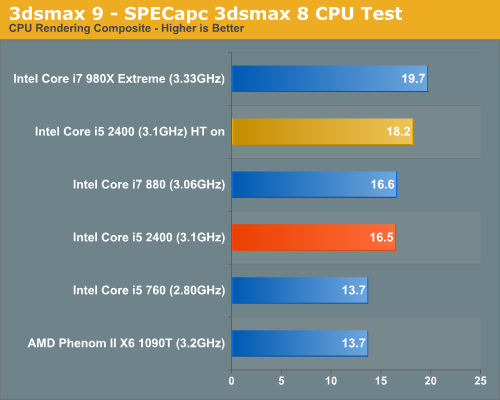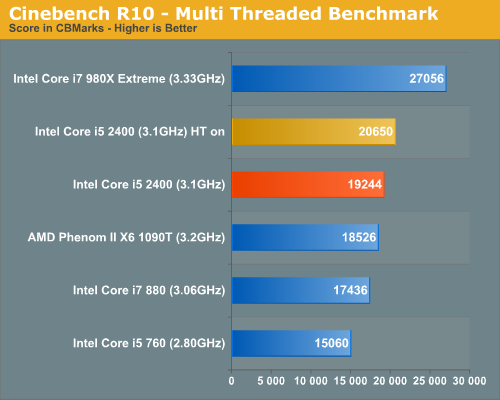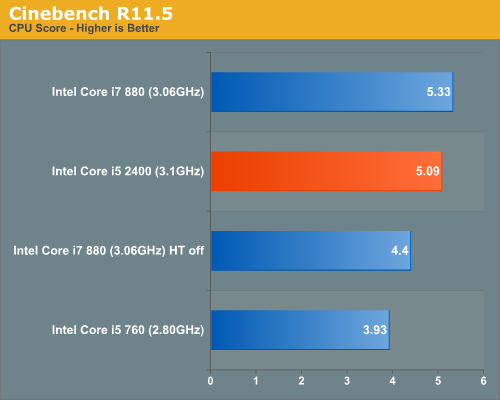The Sandy Bridge Preview
by Anand Lal Shimpi on August 27, 2010 2:38 PM EST3dsmax 9 - SPECapc 3dsmax CPU Rendering Test
Today's desktop processors are more than fast enough to do professional level 3D rendering at home. To look at performance under 3dsmax we ran the SPECapc 3dsmax 8 benchmark (only the CPU rendering tests) under 3dsmax 9 SP1. The results reported are the rendering composite scores:

This is another one of those situations where the Core i5 2400 without Hyper Threading is able to perform on par with the Core i7 880 with Hyper Threading. Compared to the i5 760 it’s 20.5% faster.
With Hyper Threading enabled, the Core i5 2400 is actually dangerously close to the 6-core 980X. Whatever Intel has done to Sandy Bridge's FP is big.
Cinebench R10
Created by the Cinema 4D folks we have Cinebench, a popular 3D rendering benchmark that gives us both single and multi-threaded 3D rendering results.

Cinebench was particularly surprising because it gives us a good opportunity to look at single threaded FP performance. Compared to a similarly clocked Lynnfield, Sandy Bridge can deliver 11% better performance. Compared to a similarly positioned Lynnfield, Sandy Bridge is about 20% faster. Note that this is without turbo enabled. The retail 3.1GHz chip should turbo up to 3.4GHz in this test, giving it a 9.6% frequency boost.
In the multithreaded test Sandy Bridge’s per-core performance is even better than Lynnfield with HT enabled.

I also ran a few numbers using Cinebench R11.5. I didn’t have the opportunity to test the i5 2400 with HT enabled in this test so I measured performance of the i7 880 with HT enabled/disabled to compare per-thread performance.

Sandy Bridge's FP performance is very good. Clock for clock we see a 15.6% improvement over Lynnfield (4C/4T vs. 4C/4T). Compared to the proposed similarly priced Core i5 760, the i5 2400 would be 29.5% faster.
POV-Ray 3.73 beta 23 Ray Tracing Performance
POV-Ray is a popular, open-source raytracing application that also doubles as a great tool to measure CPU floating point performance.
I ran the SMP benchmark in beta 23 of POV-Ray 3.73. The numbers reported are the final score in pixels per second.

The similarly positioned/priced Core i5 760 is beat by 17%. There’s no replacement for more cores/threads however as the i7 880 and X6 parts both pull ahead. Turn on HT to level the playfield (at least within Intel) and Sandy Bridge is 15% faster than Lynnfield.










200 Comments
View All Comments
foundchild1 - Friday, August 27, 2010 - link
"For example, today the fastest LGA-1156 processor is the Core i7 880. When Sandy Bridge launches early next year, the fastest LGA-1155 processor will be the Core i7 2600."Shouldn't the second one also read LGA-1156? Are they changing the pin count/socket for this 'tock'?
foundchild1 - Friday, August 27, 2010 - link
Well, that's me being an idiot and not reading the whole article first... New socket indeed.medi01 - Saturday, August 28, 2010 - link
So intel has locked multtipliers because of some other evil companies, eh? To protect the consumers, right?What a shame... :(
jfelano - Sunday, August 29, 2010 - link
Did you even read the article???? Yes its s1155.wazzap123 - Thursday, November 18, 2010 - link
The story of how caches are going to work in the 8+ core world is getting exciting. I like the overview at the daily circuit that summarizes how Niagara 3, Tilera Gx-100, and BlueGene/P processors weigh in on the issue toohttp://www.dailycircuitry.com/2010/11/progress-in-...
dendysutrisna - Friday, August 12, 2011 - link
The Apple iMac 21.5inch is a computer machine which uses the power of Intel Core i5-2400. Look at these page: http://www.bestdealscomputers.net/desktops/new-app... Processors like that, thanks to its strength, could draw the attention of everyone, even computer vendors at the level Apple also has without a doubt to hook them.Grooveriding - Friday, August 27, 2010 - link
It's hard to wade through all this data so quickly. That said, as far as overclocking, the new 2011 socket will be the successor to 1366 ?I hope with all these new overclocking controls there will still be that mainstay $300 CPU that can overclock to some extreme performance. Meaning a successor to the i7 920/930 that can deliver the amazing performance those can overclocked.
I hope this is not the death knell for such a CPU and Intel is expecting us to fork over $1000 for that performance level.
BSMonitor - Friday, August 27, 2010 - link
Good question, but judging by the road map, the Extreme and Performance segments are still Gulftown Processors. I think the 1366 stays for Gulftown.Casper42 - Saturday, August 28, 2010 - link
On the 2P Server side of things, I have been told there will be a Westmere v2 coming in January 2011.This is probably the same family that will produce the i7 990 and the other 1366 chips on the chart that don't exist yet. The Xeon 5600 and 970/980 are damn near identical aside from QPI Links.
Being those are being released in Jan, I wouldn't expect to see a socket 2011 desktop part until basically a year from now.
They will once again be a close relative to the 2P Server family. The socket for the 2P Servers will be Socket R and will be Quad Channel memory as well as supposedly having PCIe 3.0.
bitzao - Friday, August 27, 2010 - link
Yeah but.... will it run Starcraft II ? (on medium)